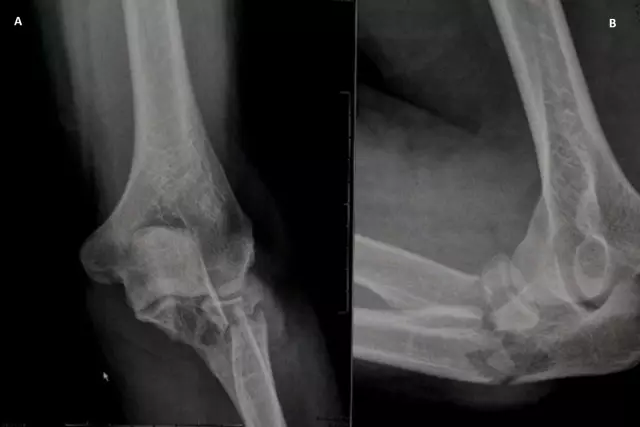- Author Rachel Wainwright [email protected].
- Public 2023-12-15 07:39.
- Last modified 2025-11-02 20:14.
Fracture of the base of the skull

A fracture of the base of the skull is a severe injury, accompanied by a fracture of one or more bones included in the base of the cerebral section of the skull - occipital, temporal, ethmoid, wedge-shaped.
Such injuries are statistically rare, accounting for only 4% of the number of severe traumatic brain injuries, and most often occur as a result of a car accident, falls from a great height, as well as strong blows to the nose or lower jaw.
A fracture of the base of the skull is accompanied by damage to the membranes of the brain, which causes the outflow of cerebrospinal fluid (CSF) through the nasal and oral cavities, orbit, and middle ear cavity. In most cases, this leads to the appearance of post-traumatic pneumocephalus - infection of intracranial contents due to the penetration of pathogens.
Skull base fracture anatomy
Fractures of the base of the skull are subdivided into lesions of the anterior and posterior parts of its base. The first type of fracture includes injuries to the temporal, occipital and posterior parts of the sphenoid bones. The second - fractures of the ethmoid and sphenoid bones. The most common of them is a fracture of the temporal bone (in more than 75% of cases), depending on the location of the damage line relative to the longitudinal axis of the temporal bone pyramid, it can be transverse, longitudinal and mixed.
Occipital fractures carry a high risk of damage to large blood vessels, nerves, and spinal cord. Injuries to the cranial nerves are fraught with paralysis of the oculomotor and facial nerves or hearing loss due to trauma to the vestibular cochlear nerve.
Symptoms of a skull base fracture are:
- Bleeding from the ears or nose;
- Outflow of cerebrospinal fluid from the ears (otoliquorrhea) or nose (rhinoliquorrhea);
- Accumulation of blood secretions in the tympanic cavity;
- The symptom of "glasses" (the so-called "raccoon eyes") - periorbital ecchymosis;
- Battle's symptom - ecchymosis in the area of the mastoid process of the temporal bone;
- Vomiting, nystagmus, hearing impairment;
- Visual impairment - in case of pinching of the optic nerve by broken bones;
- Violations of vital functions: hemodynamics, respiration.
Consequences of a fracture of the base of the skull

A fracture of the base of the skull is a dangerous injury, fatal to both the brain and the spinal cord, since the base of the skull is the unifying link of the entire central nervous system of a person. The consequences of a skull base fracture can be varied, ranging from small curvatures of the spine, frequent headaches, uncontrollable high blood pressure, to meningitis, encephalitis, complete paralysis or death.
The quality of life of a victim who has suffered a fracture of the skull base depends on the nature and severity of the traumatic brain injury, the presence of infection of the meninges, and concomitant pathologies.
Skull base fracture treatment
Patients should be treated for a skull base fracture in the neurosurgical department of the hospital. Distinguish between conservative and surgical methods of treatment. The leading role in the conservative method of treatment is taken by the prevention of intracranial complications, for which, immediately after the patient is admitted to the hospital, intravenous, intramuscular, endolumbar or subarachnoid administration of broad-spectrum antibiotics is prescribed.
In cases of the occurrence of depressed penetrating lesions of the lateral and anterior parabasal sinus, a multi-fragmented fracture of the anterior cranial fossa, conservative treatment is meaningless. Surgical methods also treat relapses of intracranial purulent complications, nasal liquorrhea. However, in each individual case, an experienced neurosurgeon decides whether surgery is necessary.
The information is generalized and provided for informational purposes only. At the first sign of illness, see your doctor. Self-medication is hazardous to health!






